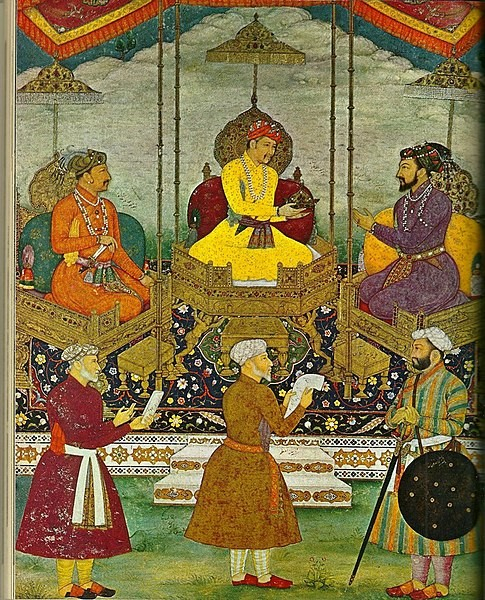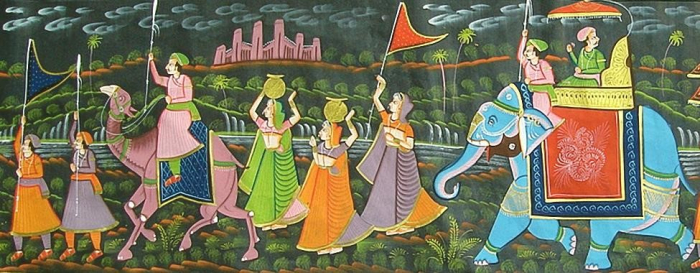

The art of miniature paintings in India can be traced back to the 9th- 10th centuries. This art became dominant in the reign of Buddhist pala rulers of eastern India. Jains also used miniature paintings in their manuscripts. With the invention of paper, the evolution of miniature paintings is seen in medieval India. It became famous in the Lodi empire but the art of miniature painting reached its zenith during the Mughal empire. Mughal paintings spread throughout the Indian subcontinent from the 16th to 19th century. The Mughal miniature painting is known for its complexities and has a long range of varieties and themes. The Mughal emperors were great patrons of arts and that is why miniature painting evolved during the Mughal period. Mughals are credited with the mixture of Indian arts with Persian and European forms of paintings. The peak of miniature painting was seen in the Mughal era. The artists blended Islamic, European and Hindu culture and aesthetics in these paintings.

Bichitr, CC BY 2.0 lt;https://creativecommons.org/licenses/by/2.0>, via Wikimedia Commons
The most famous blend was Indian-Iranian artwork, and it was vastly used in Mughal courts. After the decline of the Mughal empire new schools of paintings emerged, which started using miniature artworks. The new styles of paintings were the Pahari painting and the Rajsthani painting.
The term miniature simply means small paintings. These are the colourful handcrafted small paintings that became famous in medieval India.
Miniature paintings were used in earlier manuscripts to capture the aesthetic of that era.
The Pala kings were considered the pioneers of miniature painting but this art reached its zenith during the Mughal reign.
Buddhists used these paintings to depict the teachings of Buddha. They used such paintings in their manuscripts to popularise the teachings of Buddha.
The amalgamation of Indian painting and Persian painting gave birth to the Mughal painting.
Generally, these paintings were painted to depict the lifestyle of rulers and their approach toward their subjects.
These paintings often sowed the greatness and valour of Kings.
In some paintings, mythological characters were depicted.
Miniature painting started in India under the Pala rulers, who ruled eastern India during 750 AD.
Palas were followers of Buddha and initially Buddhist.
Buddhists used to depict the teachings and life of Buddha on Palm leaves, and leaves were small so, they had to draw small pictures of buddha and that is how the miniature painting came to be popularised.
Around 950AD, Miniature paintings were popularised in western India, under the rule of the Chalukya Dynasty.
The early miniature paintings contained mythological and religious themes.
The shift in the tradition of miniature paintings was seen during the Mughal empire.
The miniature paintings were extensively used in the autobiography of Babur.
Mughals started the amalgamation of Indian miniature art with the Persian paintings and that is how the Mughal painting originated.
Akbar was the great patron of miniature paintings, and this art reached its zenith during the Mughal empire.
The artists during the Mughal period were highly respected and praised, this was another reason for the popularisation of miniature paintings.
Even after the fall of the Mughal empire, the artists enjoyed a level of respect under the Rajput rulers of Rajasthan.
The new school of miniature painting, Rajasthan painting emerged.

Rajasthani Painting
Onef9day, CC BY 3.0
Miniature paintings were small handmade, colourful paintings, made on a piece of cloth, paper or leaves.
They take the name miniature from their small size.
The purpose of miniature painting was to include pictorial descriptions in written manuscripts.
Most significant feature of miniature painting was the complex brushwork which led to their unique identity.
The colours used in paintings were extracted from natural sources like fruits, vegetables, stones, gold and silver.
Every artist had his theme and speciality, but they were mostly influenced by Indian mythology and Vedic arts like Ragas and religious stories.
Miniature paintings were made to be used in books and autobiographies of kings.
These paintings were the pictorial depiction of the true events and the cultural life at that time.
During the Mughal empire, the Indian style of miniature paintings was combined with Persian and European paintings and gave birth to the Mughal paintings.
The Rajsthani style often depicted the story of Radha and Krishna and they also showed the stories of the bravery of kings.
The Orissa school used to depict the majestic landscape of eastern parts of India and used bold strokes.
Jain school used the most vibrant colours like Green, Gold, Red and Blue.
The art of miniature painting in India has a rich history. Initially, the Buddhists and Jain used these kings of small paintings to depict the teachings of Buddha and Tirthankara on palm leaves. The size of Palm leaves was compact so they had to draw small pictures and from there the art of miniatures evolved. It is similar to the books of the present time. The small pictures in books are inserted for a better understanding of the subject materials. The art of miniature painting reached its height during the Mughal empire. Mughals were great patrons of the arts. They brought the Persian form of painting with them which was Indianised and formed a new style of painting, called the Mughal painting. Babur was the first Mughal ruler to use miniature paintings in his autobiography and the most development of Mughal painting was seen in the reign of Akbar.
Q1. What was the art of miniature painting?
Ans. Miniature painting was an art of small colourful handmade pictures on clothes or ivory. It was started in India in the 9th century by the Buddhists and Jains. This painting reached its full potential during the Mughal empire.
Q2. Why these paintings are called miniature paintings?
Ans. The name miniature painting is directly associated with the size of such paintings. These paintings were small in size and that is why they were called miniature.
Q3. What was the contribution of Jhangir to Mughal paintings?
Ans. Jhangir kept the tradition of miniature painting alive and he brought some changes to it. Jhangir brought naturalism and the highest degree of scientific correctness to these paintings. He focused on the complexity and accuracy of paintings.
Q4. What kinds of colours were used in the painting?
Ans. During the Mughal empire, the artists used opaque colours, which were extracted from natural sources like vegetables and leaves. They often used stones and precious metals also.
Q5. What was the common feature of Rajsthani paintings?
Ans. The Rajsthani paintings showed the story of Ramayana and the lifestyle of royal families. They also painted the legacy of rulers.